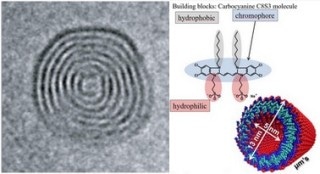Oct 11 2019
Researchers from the University of Groningen (the Netherlands) and the University of Würzburg (Germany) have used advanced spectroscopy together with a microfluidic system to examine a simple biomimetic light-harvesting system.
 Left panel: Cross-section of a natural light-harvesting antenna from bacteria, showing many nested nanotubes. Right panel: Illustration of the artificial light-harvesting system. (Image credit: Left: EM picture from PNAS 106, 8525 (2009)/Right: University of Groningen)
Left panel: Cross-section of a natural light-harvesting antenna from bacteria, showing many nested nanotubes. Right panel: Illustration of the artificial light-harvesting system. (Image credit: Left: EM picture from PNAS 106, 8525 (2009)/Right: University of Groningen)
At low light intensities, the double-walled nanotubes function very efficiently. At high intensities, they are able to eliminate surplus energy. These properties are beneficial for designing innovative materials for harvesting and transporting photon energy. The study outcomes were reported in the October 10th issue of the Nature Communications journal.
Natural photosynthetic complexes exhibit immense potential to efficiently harness sunlight, even under dark environments. This has led to extensive interest in interpreting the functionality of these materials. Gaining insights into energy transport at the nanoscale level is paramount for a variety of promising applications in the domain of (opto)electronics.
The breathtaking complexity of natural photosynthetic systems that comprise a number of hierarchically arranged sub-units led researchers to focus their attention on biomimetic analogs, which have structures similar to their natural equivalents but can be more easily regulated.
Light-Harvesting Molecules
The Theory of Condensed Matter group and the Optical Condensed Matter Science group (both at the Zernike Institute for Advanced Materials, University of Groningen) have collaborated with researchers from the University of Würzburg (Germany) to obtain a complete picture of energy transport in an artificial light-harvesting complex.
They applied a novel spectroscopic lab-on-a-chip method, which brings together microfluidics, advanced time-resolved multidimensional spectroscopy, and extensive theoretical modeling.
The team examined an artificial light-harvesting device, which was inspired by the multi-walled tubular antenna network of naturally occurring photosynthetic bacteria. The biomimetic device comprises nanotubes composed of light-harvesting molecules, self-assembled into a double-walled nanotube.
However, even this system is rather complex.
Maxim Pshenichnikov, Professor of Ultrafast Spectroscopy, University of Groningen
His team developed a microfluidic system, wherein the tube’s outer wall can be selectively dissolved and, thus, turned off. “This is not stable, but in the flow system, it can be studied.” In this manner, the researchers could analyze both the inner tube and the whole system.
Adapting
The system, at low light intensity, absorbs photons in both walls, forming excitations or excitons.
Due to the different sizes of the walls, they absorb photons of different wavelengths. This increases the efficiency.
Maxim Pshenichnikov, Professor of Ultrafast Spectroscopy, University of Groningen
At high light intensity, a significant number of photons are absorbed, forming a massive number of excitons.
We observed that, when two excitons meet, one of them actually ceases to exist.
Maxim Pshenichnikov, Professor of Ultrafast Spectroscopy, University of Groningen
This effect serves as a sort of safety valve, as high numbers of excitons could deform the nanotubes.
Molecular Materials
Thus, the researchers also showed that the double-walled molecular nanotube could adapt to varying illumination conditions. At low light conditions, they imitate the vital functional features of nature’s design toolbox by behaving as extremely sensitive antennas but eliminate surplus energy at high intensities when there is excess light—a situation that would not typically happen in nature.
Both these properties enable improved control of the movement of energy via complex molecular materials.